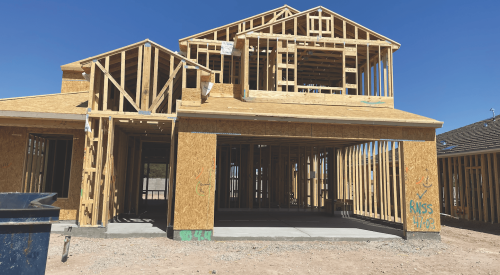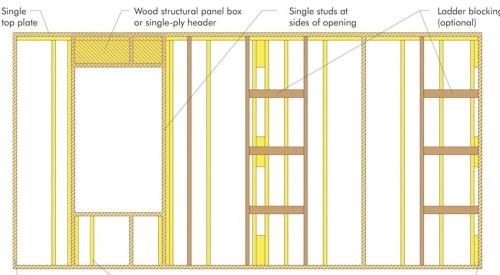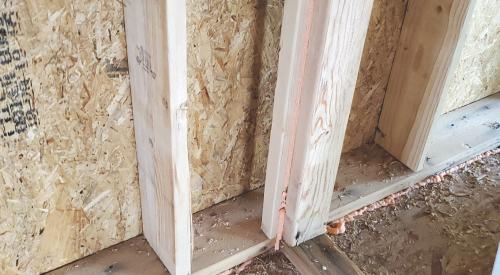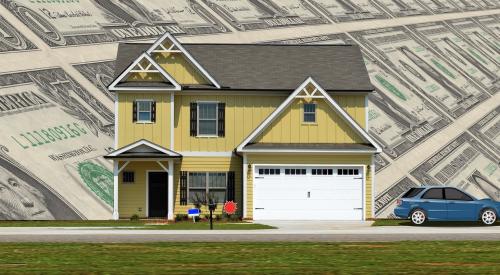Builders who aren't selling to the mansion market can afford to build green homes. Many building techniques and products labeled green are labor and resource efficient, so they cost a builder less. A floor plan under 1,500 square feet, framing techniques that save lumber and smaller diameter pipes that save water may not make the pages of glossy consumer home magazines, but designs and technologies like these can help you build an affordable green home while making a profit.
Build small
 |
|
OVE methods for open-corner framing leave space for insulation where conventional framing methods leave none. |
Rob Hart offers his clients green on a budget. President of HartMarin in Novato, Calif., Hart recently completed Virginia Groves, an eight-unit subdivision in Novato that showcases environmentally conscious development practices and includes affordable housing. Hart put 60 percent of the units (five homes) on the market for half the average price of new homes in the area.
The single-family detached Virginia Groves homes range from 1,150 to 1,350 square feet. According to the National Association of Realtors' MLS records, the average home in Novato spent 110 days on the market in August 2007. Virginia Groves homes have been selling almost
 |
| Correctly spacing studs and rafters saves lumber because one top-plate can be used instead of two. |
A year-long study conducted by the city of Davis, Calif., in 1974 showed that a properly sited house enjoys substantially lower heating and cooling bills than an identical house sited perpendicular to that.
Passive solar design goes beyond turning your home plan on its axis. Place high-mass materials such as brick, stone or concrete where they can absorb the sun's heat during the day and release it at night.
Brad Lancaster, a permaculture landscape designer in Tucson, Ariz., says that proper shading with plantings, arbors and eaves can reduce cooling bills by another 25 percent.
Use advanced framingOptimum value engineering uses engineering principles to reduce framing materials while still
 |
|
Header hangers, nailers and right-sized headers save time and money on a job site. For non-load bearing walls, no header is necessary in most zones. |
Fewer framing members not only save wood and take less time to install, but they also leave more space for insulation. Reducing the amount of framing also cuts down on thermal breaks.
According to the NAHB Research Center, using OVE saves about 35 studs in a two-story 1,120 square foot house, or about $500. Estimated labor savings are 3–5 percent of framing costs.
 |
| Home run plumbing, pictured here, uses color-coded flexible pipes and a plumbing manifold that acts like a circuit breaker for you water. Photo courtesy of PATH. |
Using flexible, cross-linked polyethylene piping and a plumbing manifold, the combination, known as home run plumbing, saves water and offers outstanding durability. The flexible 38-inch piping requires fewer fittings than rigid pipe, providing more consistent water pressure that delivers hot water to the faucet faster than conventional pipes. With better inherent insulation than copper or PVC piping, PEX keeps water hotter, too. PEX piping doesn't rust or develop pinhole leaks like copper piping, and being able to turn water off at the manifold with the flick of a switch makes it easier to repair leaky faucets.
What's in it for the builder? Home run plumbing installs more quickly than rigid copper or PVC pipe. Although materials for home run plumbing may cost 33 percent more than conventional materials (due largely to the price of the manifold), it's worth the initial outlay.![]()
 |
 |
|
The smaller footprint of Virgina Groves' homes in Novata, Calif., allows more outdoor space that translates well for buyers. According to MLS records, in August 2007, the average home in Novato spend 100 days on the market. Photo courtesy of HartMarin. |
Depending on your municipality, separating job site waste for recycling could save money on dump fees. Scrap metal can be sold to a scrap yard, drywall can be ground up as soil amendment and scrap lumber can be given a new life.
Recycling isn't just for the end of a job. Consider stopping by one of the more than 500 Habitat for Humanity Habitat ReStores nationwide. These and other recycled building material stores offer everything from doors to ductwork, usually priced at 30–50 percent below retail costs.
Instead of leaving extra building materials on site or hauling those rejected cabinets to a dump, you can also donate them to a ReStore, which will save on dump fees and earn your business a tax-deductible write-off.
Learning how to build green now could open new business opportunities in the future. It has for Hart, who has become a green building consultant.
| Author Information |
| Kelly Cutchin writes about better building practices on behalf of the Partnership for Advancing Technology in Housing. PATH is administered by the U.S. Department of Housing and Urban Development. Learn more at www.pathnet.org |












